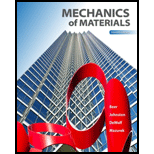
Concept explainers
Find the magnitude and location of the largest downward deflection of the beam.
Answer to Problem 61P
The location of the largest downward deflection is
The largest downward deflection of the beam is
Explanation of Solution
Given information:
The modulus of elasticity of the material is
Calculation:
Show the free-body diagram of the beam AD as in Figure 1.

Write the singularity equation for load intensity as follows;
Integrate the equation to find the shear force.
By definition, the change in bending moment with respect to change in distance is shear force.
Integrate the equation to find the bending moment.
Write the second order differential equation as follows;
Here, the moment at the corresponding section is
Substitute
Integrate the equation with respect to x;
Integrate the Equation (2) with respect to x.
Boundary condition 1:
At the point D;
Substitute 16 ft for x and 0 for M in Equation (1).
Boundary condition 2:
At the point A;
Substitute 18.84375 kips for
Boundary condition 3:
At the point D;
Substitute 18.84375 kips for
Refer to Appendix C “The properties of the Rolled-Steel Shapes” in the textbook.
The moment of inertia of the
At point A;
Substitute
At point B;
Substitute
At point C;
Substitute
At point D;
Substitute
The slope changes from negative to positive in the section BC.
The maximum deflection occurs where the slope changes sign. i.e.,
Substitute 0 for
Solve the equation;
Therefore, the location of the largest downward deflection is
At largest deflection point;
Substitute
Therefore, the largest downward deflection of the beam is
Want to see more full solutions like this?
Chapter 9 Solutions
Mechanics of Materials, 7th Edition
- please find Ix and Iy in mm4arrow_forwardHomework#7arrow_forwardComputing Angles of Rotation and Angles of Tilt In each of the following problems, the axis of a hole is shown in a rectangular solid. In order to position the hole axis for drilling, the angle of rotation and the angle of tilt must be determined. Compute angles to the nearer minute in triangles with customary unit sides. Compute angles to the nearer hundredth degree in triangles with metric unit sides. a. Compute the angle of rotation, R. b. Compute the angle of tilt, T. 7. Given: H= 2.600 in. L = 2.400 in. a. W= 1.900 in. 8. Given: H= 55.00 mm b. Use this figure for #7 and #8. AXIS OF HOLE L 48.00 mm W= 30.00 mm H a. b. 9. Given: H = 4.750 in. L = 4.000 in. W= 3.750 in. a. 10. Given: H=42.00 mm b. L37.00 mm W = 32.00 mm a. b. 11. Given: H = 0.970 in. L = 0.860 in. W= 0.750 in. a. 12. Given: H= 22.00 mm L 18.00 mm = W = 15.00 mm a. b. Use this figure for #9 and #10. ZR AXIS OF HOLE Use this figure for #11 and #12. H b. L AXIS OF HOLE Tarrow_forward
- This is a tilt and rotation question. Here are notes attached for reference. I prefer handwritten solutions. ONLY UPLOAD A SOLUTION IF YOU ARE SURE ABOUT THE ANSWER PLEASE. I prefer handwritten solutions.arrow_forwardConsider a constant area semi-infinite fin of a circular cross section of radius r. and thermal conductivity k. The base is maintained at T. and the surface of the fin exchanges heat by convection to an ambient fluid at T with a heat transfer coefficient h. It is desired to increase the heat transfer from the fin. The following suggestions are made: (i) doubling k, (ii) doubling ro, (iii) doubling h. Which suggestion will bring about the largest increase in heat transfer? To x h, T C A h, Tarrow_forwardA 20 cm long 304 stainless steel bar is initially at 18°C. One end of the bar is suddenly maintained at 100°C. Assuming that your finger can tolerate a 60°C temperature, what is the longest time you are willing to wait before you touch the other end? Be on the safe side and select a conservative model. h,T oil bath glass ballarrow_forward
- Small glass balls of radius 1.1 mm are cooled in an oil bath at 22°C. The balls enter the bath at 180°C and are moved through on a conveyor belt. The estimated heat transfer coefficient is 75 W/m²-ºC. What should the conveyor speed be so that the balls leave at 40°C? The length of bath is 2.5 m.arrow_forwardJust do Questions 7, 9, 11. Here are notes attached for reference. I prefer handwritten solutions. ONLY UPLOAD A SOLUTION IF YOU ARE SURE ABOUT THE ANSWER PLEASE.arrow_forwardThis is a tilt and rotation question. Here are notes attached for reference. I prefer handwritten solutions. ONLY UPLOAD A SOLUTION IF YOU ARE SURE ABOUT THE ANSWER PLEASE. I prefer handwritten solutions.arrow_forward
 Elements Of ElectromagneticsMechanical EngineeringISBN:9780190698614Author:Sadiku, Matthew N. O.Publisher:Oxford University Press
Elements Of ElectromagneticsMechanical EngineeringISBN:9780190698614Author:Sadiku, Matthew N. O.Publisher:Oxford University Press Mechanics of Materials (10th Edition)Mechanical EngineeringISBN:9780134319650Author:Russell C. HibbelerPublisher:PEARSON
Mechanics of Materials (10th Edition)Mechanical EngineeringISBN:9780134319650Author:Russell C. HibbelerPublisher:PEARSON Thermodynamics: An Engineering ApproachMechanical EngineeringISBN:9781259822674Author:Yunus A. Cengel Dr., Michael A. BolesPublisher:McGraw-Hill Education
Thermodynamics: An Engineering ApproachMechanical EngineeringISBN:9781259822674Author:Yunus A. Cengel Dr., Michael A. BolesPublisher:McGraw-Hill Education Control Systems EngineeringMechanical EngineeringISBN:9781118170519Author:Norman S. NisePublisher:WILEY
Control Systems EngineeringMechanical EngineeringISBN:9781118170519Author:Norman S. NisePublisher:WILEY Mechanics of Materials (MindTap Course List)Mechanical EngineeringISBN:9781337093347Author:Barry J. Goodno, James M. GerePublisher:Cengage Learning
Mechanics of Materials (MindTap Course List)Mechanical EngineeringISBN:9781337093347Author:Barry J. Goodno, James M. GerePublisher:Cengage Learning Engineering Mechanics: StaticsMechanical EngineeringISBN:9781118807330Author:James L. Meriam, L. G. Kraige, J. N. BoltonPublisher:WILEY
Engineering Mechanics: StaticsMechanical EngineeringISBN:9781118807330Author:James L. Meriam, L. G. Kraige, J. N. BoltonPublisher:WILEY





